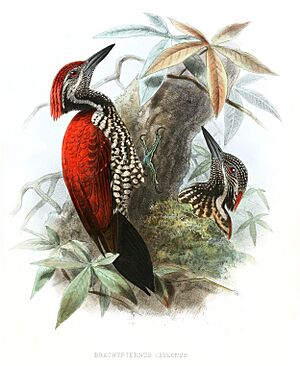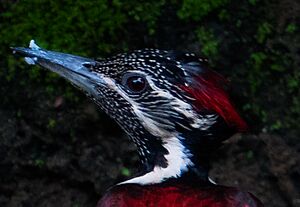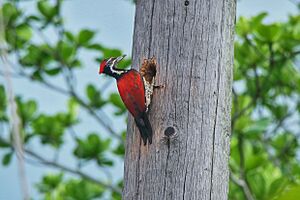Red-backed flameback facts for kids
Quick facts for kids Red-backed flameback |
|
|---|---|
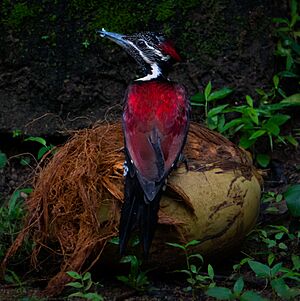 |
|
| Female | |
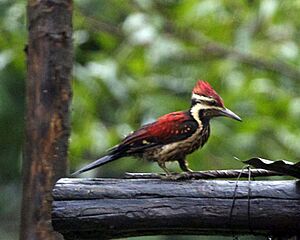 |
|
| Male | |
| Conservation status | |
| Scientific classification | |
| Genus: |
Dinopium
|
| Species: |
psarodes
|
| Synonyms | |
|
Dinopium benghalense psarodes Brachypternus ceylonus (Legge, 1880) |
|
The Red-backed flameback (Dinopium psarodes) is a type of bird that belongs to the Picidae family. This family includes woodpeckers. People also call it the Lesser Sri Lanka flameback or Sri Lanka red-backed woodpecker. This bird lives only in Sri Lanka, an island country. You can find it almost everywhere there, except in the very far north. Some scientists used to think it was a subspecies of the Black-rumped flameback, but now it is seen as its own species.
Contents
About the Red-backed Flameback
The Red-backed flameback is a special bird that lives only in Sri Lanka. It's known for its bright colors and unique habits.
How Scientists Study This Bird
Scientists have studied the Red-backed flameback for a long time. Back in 1880, a scientist named William Vincent Legge first described it as a unique species. He placed it in a group called Brachypternus. Later, some scientists thought it was just a type of Black-rumped flameback.
However, a recent study by Sampath S. Seneviratne and his team showed that it is a full species. They found that the Red-backed flameback can sometimes breed with the Black-rumped flameback. This mixing mostly happens in a specific area in northern Sri Lanka. When these two types of flamebacks breed, their offspring (called hybrids) are not as strong or successful as the pure Red-backed or Black-rumped flamebacks. This is why the two types remain separate species.
Red-backed Flameback's Relatives
The Red-backed flameback is one of three types of red-colored flamebacks found only in Sri Lanka and the Philippines. The other two are the Crimson-backed flameback from Sri Lanka and the Luzon flameback from the Philippines. It's interesting that these birds, living in different places, both evolved to be red. This suggests that something in their environments made being red a good thing for them.
What the Red-backed Flameback Looks Like
This bird is about 28 centimeters (11 inches) long. It's mostly a bright crimson red. Its wings have black edges. The underside of its body is white with messy black marks. Its chest and neck are black, with white spots on the throat. There are also white streaks on its chest.
A black stripe goes from its eye to the back of its neck. White streaks are visible between its eye and neck. The top of its head (crown) is red. Female birds have black spots mixed with white on their forehead. The Red-backed flameback has a medium-sized gray beak that ends in a blunt point.
Young Red-backed flamebacks are not as brightly colored. Their markings are not as clear. Young males have white spots on their crowns. Young females have very few spots, or none at all.
If you see a hybrid bird (a mix of Red-backed and Black-rumped flamebacks), its colors can vary. It might be mostly red with some orange or yellow, looking more like a Red-backed flameback. Or it could be mostly yellow with some red or orange, looking more like a Black-rumped flameback.
Where the Red-backed Flameback Lives
The Red-backed flameback lives in different kinds of forests. These include dry forests, moist lowland forests, and mangrove forests. You can also find them in places made by people, like home gardens. They can live at heights up to 1500 meters (about 4,900 feet). They are mostly found in the drier parts of Sri Lanka, but they still like places that are humid.
How the Red-backed Flameback Lives
Sounds and Calls
The Red-backed flameback has a sharp, loud call. It sounds like a whinny, but it's not very musical. It's more like a screech. It might make a rhythmic sound like "woik-woik-wik-wi-ti-ti-t-t t-t-trrrrrr!" or a repeated "woik-tri-tri-tri-tri-tri-tri-tri- !" that lasts for about three seconds. It also makes a dull drumming sound on trees, which lasts for about 0.8 to 1.5 seconds.
What the Red-backed Flameback Eats
The main food for the Red-backed flameback is ants. They especially like Carpenter ants and ants from the genus Meranoplus. They also enjoy eating the pupae and larvae of Asian weaver ants. Besides ants, they eat other small creatures like spiders, caterpillars, weevils, and beetles. Sometimes, they also eat fruit to get important nutrients.
How the Red-backed Flameback Finds Food
The Red-backed flameback uses its strong tail to help it climb trees. When it flies, it moves in a bouncy way, flapping its wings and then gliding. It can break into the leaf nests of weaver ants high up in trees. But it also goes down to the ground to find nests of ants that live there.
This bird usually looks for food alone or in pairs. Sometimes, a whole family group will forage together. Like other Dinopium flamebacks, it often joins groups of different bird species that are all looking for food together.
Reproduction and Nesting
The Red-backed flameback drills holes in trees to make its nests. These holes can be at different heights. Only woodpeckers, barbets, and other birds in the Piciformes group can make these kinds of holes. These holes are very important because other birds, like parrots, cannot make their own nests and use these holes.
The Red-backed flameback usually lays one set of eggs (a clutch) per season. Sometimes, it might lay two clutches. They breed from December to September, but mostly from August to September and from February to June. Each time, they lay two or three eggs.
Protecting the Red-backed Flameback
The Red-backed flameback is listed as a least concern species by the IUCN Red List. This means that scientists are not worried about it becoming endangered right now. Its population is stable, even though the exact number of birds is not known. It is common, or at least locally common, in the areas where it lives.
Scientists have not found any major threats to this bird. It is one of the most common birds that live only in Sri Lanka. Other common endemic birds include the Sri Lankan junglefowl, the Sri Lanka hanging parrot, and the Crimson-fronted barbet. The Red-backed flameback is actually the most common woodpecker species in Sri Lanka.



